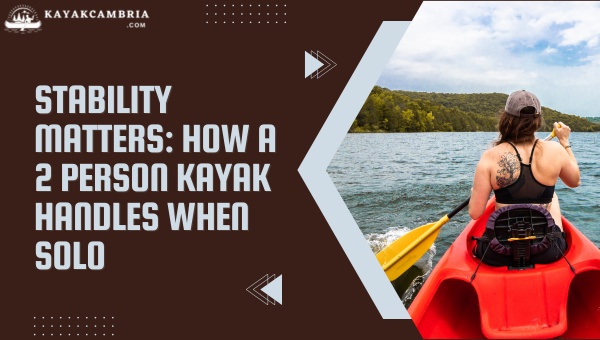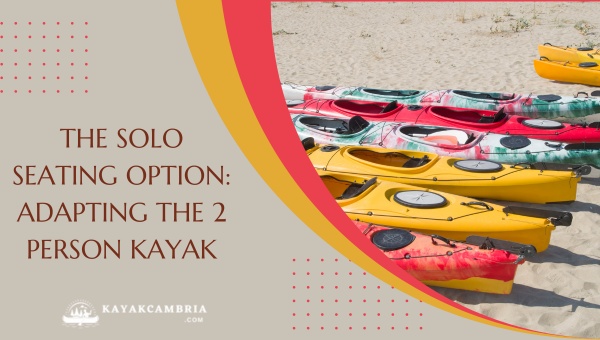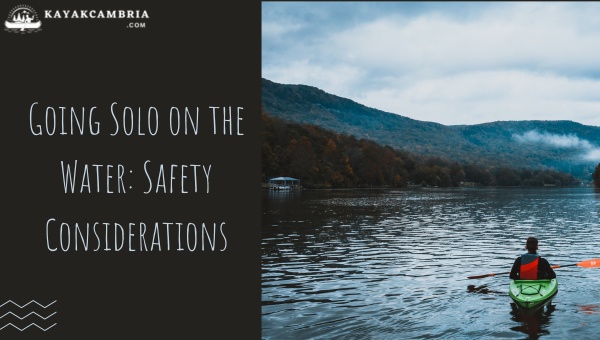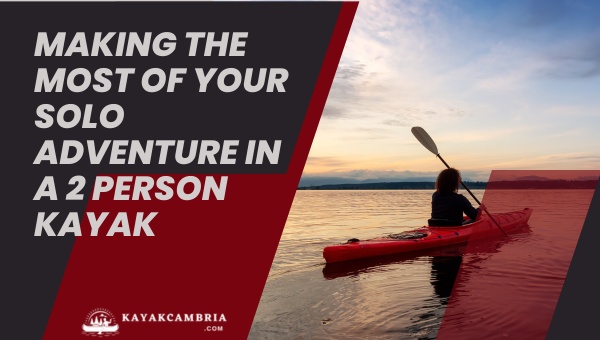Kayaking is an incredible way to explore the great outdoors, navigating through serene lakes, rushing rivers, and mesmerizing coastlines. As someone who loves this brilliant sport, I often find myself craving a solo adventure, paddling in the tranquility of nature without any distractions. However, there are times when having a 2 person kayak, also known as a tandem kayak, is more reasonable – whether for the company of a friend or to accommodate extra gear. This led me to wonder: Is it possible to actually enjoy a solo kayak session on a 2 person kayak?
Undoubtedly, plenty of other kayaking enthusiasts have pondered the same question – can one person use a 2 person kayak, or should we consider investing in both tandem and solo kayaks? To answer this intriguing question, it’s important to examine the stability, paddling efficiency, seating options, safety considerations, and the potential benefits of solo kayaking in a tandem vessel. Join me on this in-depth exploration of tandem kayaking and find out whether it’s truly suitable for your solo adventures or if it’s best to stick with a single-person kayak!
Contents
Contents
Stability Matters: How A 2 Person Kayak Handles When Solo?

When it comes to kayaking, stability is a crucial factor. Typically, tandem kayaks, also known as 2 person kayaks, offer better stability compared to single kayaks due to their more extensive design. However, it is important to note that when paddling solo in a tandem kayak, optimal weight distribution is essential for maintaining this stability.
Weight Distribution and Balance
Weight distribution plays a significant role in the stability of a kayak. In a tandem kayak, where there are two paddlers, the weight is more evenly spread along the hull, which helps in maintaining the kayak’s stability. But when paddling solo, one might think that sitting in the middle is the best option. While, in some cases, it might be beneficial, positioning yourself in the middle can also lead to a bow- or stern-heavy situation. This imbalance can make it difficult to maintain stability and control.
To counteract this, when paddling solo in a tandem kayak, it is vital to distribute weight evenly, both front-to-back and side-to-side. This can be achieved with proper seating adjustments and using gear or ballast if necessary. For example, you can position some of your gear, dry bags, or a cooler in an empty position to help with weight distribution.
Additional Stability Factors to Consider
Although tandem kayaks are generally more stable due to their larger size, your individual skill set should not be overlooked. A more seasoned kayaker would likely feel more confident in managing the stability of a 2 person kayak when solo. In contrast, beginner kayaker might find it trickier to handle a tandem kayak on their own.
Moreover, other factors, such as water conditions and weather, should also be taken into consideration to ensure a safe and enjoyable solo kayaking experience in a 2 person kayak.
Paddling a 2 person kayak solo can offer ample stability, provided that you focus on proper weight distribution and take into account your skill level and paddling conditions.
Paddling Efficiency: Maneuvering A Tandem Kayak On Your Own

As someone who has paddled both single and tandem kayaks, I can safely say that paddling a tandem kayak on your own presents some unique challenges. While it’s undoubtedly doable, there are a few key differences that affect maneuvering and paddling efficiency that one must consider when going solo in a two-person kayak.
Steering and Extra Length
One of the most noticeable differences is the extra length of a tandem kayak. The added length affects the kayak’s turning radius and can make it trickier to maneuver around tight corners or obstacles. Paddling alone means you must adapt your technique to account for the extra size.
To maintain control and efficiency, it’s important to adjust your paddling strokes accordingly. This might involve practicing a more sweeping motion with each stroke, or incorporating corrective strokes such as the draw or pry to maintain a straight path while paddling. Familiarizing yourself with these techniques ensures that you can take full advantage of the tandem kayak’s capabilities, even without a second paddler.
Differences in Paddling Techniques
When paddling a 2 person kayak alone, it’s essential to understand the differences between tandem and solo paddling techniques. In a tandem kayak, the two paddlers typically work in unison to propel and steer the vessel, while a single paddler must rely solely on their strength and skill to achieve the same results.
To maintain optimal efficiency when paddling a tandem kayak alone, you may need to experiment with different paddle strokes and techniques, paying special attention to the angle and depth of each stroke. You might also find it helpful to use a longer paddle to compensate for the additional width of the kayak and better reach the water’s surface.
Embracing the Challenge
Ultimately, maneuvering a 2 person kayak on your own may be more challenging than using a single kayak, but it’s not impossible. By familiarizing yourself with the nuances of tandem kayaking and adapting your techniques to its unique characteristics, you can tackle the challenge with confidence.
With practice and patience, coupled with the proper equipment and techniques, you can hone your paddling skills and optimize efficiency on your solo adventures in a two-person kayak. And while it might not be as efficient as paddling a single kayak or with a partner, the sense of accomplishment and the extra space it provides make it a worthwhile endeavor for those looking to broaden their kayaking horizons.
The Solo Seating Option: Adapting The 2 Person Kayak

One of the primary concerns when paddling a tandem kayak alone is weight distribution and maintaining the right balance. Fortunately, many 2 people kayaks nowadays offer adjustable seating positions. This feature allows you to effectively adapt the seating configuration for solo use and optimize the kayak’s performance when you’re out on the water alone.
Adapting Configuration for Solo Paddling
Most tandem kayaks come with seats that can be moved or adjusted easily. This means you can shift your position so that you’re seated more in the center of the kayak. When doing so, it’s essential to ensure that the new seating position offers adequate stability and optimal weight distribution. This will make it easier to control and maneuver the kayak effectively.
It’s also important to take into consideration the kayak’s overall design. Some tandem kayaks are designed with a symmetrical hull shape, which means that paddling from the center does not impact their performance. On the other hand, asymmetrical hull kayaks may perform differently when using the central seating position, so it’s crucial to test it out before heading out on the water.
Proper Equipment and Techniques
Aside from the seating adjustment, you’ll also need the right equipment and techniques to efficiently use a tandem kayak by yourself. When it comes to paddles, you might want to consider a longer paddle than you’d usually use on a solo kayak. A longer paddle will enable you to reach the water more easily and provide more power and control when maneuvering the larger kayak.
Additionally, practicing and mastering different paddling strokes becomes more important when paddling a 2 person kayak alone. Learning strokes like the sweep stroke, draw stroke, and rudder stroke will help you maintain efficient control and maneuverability of the tandem kayak.
Adapting the seating position and having the right equipment and techniques significantly improve your kayaking experience when using a 2 person kayak solo. It gives you the flexibility and control needed to navigate the water on your own, while still enjoying the many benefits that a tandem kayak offers.
Going Solo On The Water: Safety Considerations

When you decide to paddle a 2 person kayak alone, it’s crucial to put extra emphasis on safety. The size, weight, and design of a tandem kayak pose new challenges that you may not experience while using a single kayak. In this section, I will discuss some essential safety considerations that you should keep in mind when choosing to go solo in a tandem kayak.
1. Proper Gear and Equipment
Safety should be your top priority when embarking on any kayaking adventure. When navigating a 2 person kayak alone, it’s even more critical to ensure you have the proper gear and equipment. This includes a personal flotation device (PFD), whistle, paddle float, bilge pump, and a suitable paddle. Make sure your kayak and gear are in good condition before setting out.
2. Practice Self-Rescue Techniques
While solo kayaking in a 2 person kayak, you should be well-versed in self-rescue techniques. This means being able to re-enter your kayak independently in case you capsize. Practice these skills in calm and controlled environments so that you are prepared to handle any emergency on the water.
3. Check Weather and Water Conditions
Going solo in a tandem kayak requires you to be extra cautious about the environment. Check the weather forecast and be aware of any potential storms or unfavorable conditions. Moreover, be mindful of the water conditions and choose calm waters with minimal currents when paddling a 2 person kayak alone. It’s always better to err on the side of caution.
4. Stay within Your Skill Level
When embarking on a solo adventure, it’s essential to know your limits. Paddling a larger kayak alone can be more challenging, so you should only undertake this type of excursion if you are confident in your skills and experience. Avoid attempting risky maneuvers or paddling in unfamiliar waters when alone in a 2 person kayak.
5. Communication and Safety Plan
Even when solo kayaking, it’s crucial to have a safety plan in place. Inform someone onshore of your whereabouts, route, and expected return time. Carrying a fully charged communication device, such as a mobile phone or VHF radio, can be incredibly helpful in case of an emergency or sudden change in conditions.
It’s certainly possible to safely use a 2 person kayak alone if you consider the factors discussed above. By prioritizing safety and equipping yourself with the proper skills, gear, and knowledge, you can transform your tandem kayak experience into an enjoyable and safe solo adventure.
Making The Most Of Your Solo Adventure In A 2 Person Kayak

There is a unique joy found in heading out on a solo adventure with your trusty kayak, free to explore at your own pace. If you choose to paddle alone in a 2 person kayak, there are certain measures you can take to maximize your experience. In this section, I’ll go over some practical tips to ensure a satisfying and successful journey.
Properly Distribute Weight
To maintain stability and performance, make sure the weight is evenly distributed throughout the kayak. Place your gear in the middle or towards the rear, rather than at the front, to prevent tipping. In addition, consider using smaller dry bags to spread out the weight, rather than one larger bag.
Adapt Your Paddling Technique
When paddling a tandem kayak alone, it is essential to modify your technique to accommodate the boat’s size and weight. A stroke known as the sweep stroke can help you steer the kayak more effectively. To do this, place your paddle at the front of the boat and pull it along the side, in a sweeping motion. This technique will significantly improve your maneuverability.
Choose the Right Paddle
Invest in a longer paddle, as this will greatly enhance your control and efficiency in the water. A paddle with a larger blade surface area will also yield more power, compensating for the extra forces needed to propel the 2 person kayak.
Plan Your Route Wisely
Opt for a route that suits the capabilities of your tandem kayak and your skills. Keep in mind that tandem kayaks are typically less maneuverable, so selecting a route where tight turns and narrow passages will not be challenging. Prioritize open water and calmer conditions to ensure your safety and enjoyment.
Embrace the Extra Space
One fantastic advantage of taking a 2 person kayak out alone is the extra space available. Make the most of it by bringing along more gear for a longer trip, like a luxurious overnight camping excursion. This gives you the freedom to explore places that may not be accessible with a smaller, single-person kayak.
By following these tips, you can ensure that your solo adventure in a 2 person kayak is safe, enjoyable, and efficient. Embrace the unique experience and take advantage of the benefits that come with paddling a tandem kayak on your own.
Parting Thoughts: Is A 2 Person Kayak Right For Your Solo Adventures?

As we come to the end of this exploration, it’s essential to weigh the pros and cons of using a 2 person kayak for solo paddling. Can you experience a fulfilling kayaking adventure in a tandem vessel on your own? Will it cater to your specific needs? Here are a few factors to consider.
Pros:
- Extra Storage Space: A 2 person kayak offers a lot more room for storing your gear, which is especially advantageous for longer trips. With space for more provisions, you can enjoy extended solo adventures without the worry of running out of supplies.
- Potential for Company: Paddling solo might be fun, but sometimes you may decide to bring a friend or family member along. A tandem kayak provides the flexibility to accommodate a paddling partner when needed.
- Adaptability: Many manufacturers design 2 person kayaks with features that allow their use both by a single paddler or a duo. This versatility can be an excellent advantage for kayakers who enjoy both solo and tandem paddling experiences.
Cons:
- Challenges in Handling: Paddling in a 2 person kayak alone can be more challenging due to its length and width. It requires more effort and skill to steer and control the vessel as compared to single person kayaks.
- Portability Concerns: Tandem kayaks tend to be heavier and bulkier than single kayaks. Transporting and maneuvering them on and off the water can be cumbersome, especially if you are on your own.
Before making a decision, it is crucial to introspect and determine what kind of paddling experiences you genuinely want to have, as well as your skill level and physical capabilities. If you have experience in single kayaking and are up for the challenge of paddling alone in a tandem kayak, it could be an exciting new adventure for you.
On the other hand, if you’re a beginner kayaker or enjoy the ease and simplicity of solo paddling, a single-person kayak might be a more suitable choice. In the end, the decision falls on your personal preferences and how comfortable and confident you feel in your kayaking abilities.
Frequently Asked Questions
1. Can a single person paddle a 2 person kayak without issue?
Yes, a single person can paddle a 2 person kayak without any major issue. However, it would require some adjustments in seating position, proper paddling technique, and possibly additional equipment to maintain stability and control.
2. Is it more difficult to paddle a 2 person kayak alone?
It can be more challenging to paddle a 2 person kayak alone, primarily due to the vessel’s extra length and weight. Steering and maneuvering might require more effort, but with proper technique and adequate practice, it can be managed.
3. Is a 2 person kayak more stable than a single-person kayak?
Generally, a 2 person kayak is more stable than its single-person counterpart because it has a broader and longer hull. However, stability is subjective to many factors, such as the specific kayak design and paddler’s skill level.
4. Do I need any special equipment to paddle a 2 person kayak alone?
While no specific equipment is required, some kayak accessories may help in solo paddling a tandem kayak. For example, a longer paddle can be advantageous, and a rudder or skeg can assist in maintaining a straight course.
5. Can I easily switch between solo and tandem paddling in a 2 person kayak?
Yes, many 2 person kayaks allow for easy switching between solo and tandem paddling. It usually involves adjusting or relocating seats and footrests. Be sure to check the manufacturer’s recommendations for your particular kayak model.
6. Is it safe to paddle a 2 person kayak alone in rough waters?
Safety is paramount in any kayaking adventure. While a tandem kayak may provide more stability, it is crucial to consider your skill level, experience, and the specific conditions you plan to embark on. Always exercise caution, wear appropriate safety gear, and be prepared for any situation.
Conclusion
Using a 2 person kayak for solo adventures can be both feasible and enjoyable, provided you consider important factors such as stability, paddling efficiency, and safety. Adjusting the seating position and employing proper techniques can make the experience more comfortable and manageable. Additionally, having the extra space offers some unique benefits, including extra storage room for gear and personal items.
However, it’s essential to remember that every kayaker’s experience, skills, and preference may vary. While some may thrive on the adventure and challenge of solo paddling in a tandem kayak, others might find it too cumbersome or challenging. So, before heading out to explore the waters alone in a 2 person kayak, it’s important to:
- Understand your paddling abilities and limitations
- Practice proper techniques and safety precautions
- Invest in suitable gear
- Gauge your overall comfort with the vessel
Ultimately, the decision to use a 2 person kayak for solo paddling is a personal one. Think about your individual needs, preferences, and comfort levels before making your choice. At the end of the day, the most important aspect of kayaking is to have a memorable and enjoyable experience out on the water.

